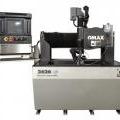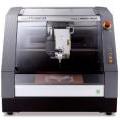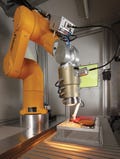Focus on Prototyping and Rapid Prototyping Equipment
October 20, 2010
 Waterjet Cutting System Performs Micromedical Prototyping
Waterjet Cutting System Performs Micromedical Prototyping
Serving as an alternative to other conventional machining methods, a waterjet cutting technology can allow for fast and accurate prototyping of medical parts. Micro waterjet nozzles developed by the company enable systems to cut smaller parts than was previously possible and to create prototypes from CAD drawings in fewer than five minutes without the need for extensive setups or tooling, according to the company. When combined with the firm's A-Jet tilting waterjet head and 2626|xp JetMachining center, the miniature waterjet nozzles can assist in the machining of complex 3-D components for biomedical applications. Able to machine such materials as stainless steel, titanium, plastics, glass, ceramics, composites, and laminates, the machining center is suited for the prototyping and manufacture of difficult-to-machine precision medical instruments and devices.
Omax Corp.
Kent, WA
www.omax.com
 Desktop Milling Machine Provides Rapid Prototyping of Medical Parts
Desktop Milling Machine Provides Rapid Prototyping of Medical Parts
Building on its manufacturer's existing advanced subtractive rapid prototyping technology, a 3-D desktop milling machine is equipped with additional features, bundled software, and a variety of options to promote versatility and ease of use. Designed for modeling and reviewing design concepts in-house, the compact MDX-40A machine emulates manufacturing processes to produce prototypes of medical devices and components that accurately reflect the finished part's functionality and appearance, according to the company. It also yields a smooth surface finish on a variety of materials. Features include a user-friendly virtual panel and support for G-Code programming, which makes the system compatible with such software programs as Mastercam, EdgeCAM, SurfCAM, and GibbsCAM. It also comes with the SRP Player CAM software, which allows the system to quickly move from CAM model to physical prototype.
Roland DGA Corp.
Irvine, CA
www.rolanddga.com
 Laser System Yields PCB Prototypes for Medical Applications
Laser System Yields PCB Prototypes for Medical Applications
Used for prototyping and production volumes, a UV laser system can make clean, burr-free cuts on FR-4, FR-5, CEM, ceramic, polyimide, and other PCB substrate materials. Capable of cutting PCBs measuring up to 250 × 350 mm, the MicroLine 1000 S laser system handles flexible and very thin substrates better than conventional cutting systems, according to its manufacturer. The UV laser beam can also cut along delicate components or circuit paths without thermal or mechanical interference. Applications include prototyping PCBs for such devices as implantable cardioverter defibrillators. The system can perform such operations as cutting, routing, skiving, drilling, cutting pockets, structuring of etch or solder resist, and micromachining of ceramic substrates for medical applications.
LPKF Laser & Electronics
Tualatin, OR
www.lpkfusa.com
 3-D Printer Produces 'Instant' Prototypes
3-D Printer Produces 'Instant' Prototypes
A personal 3-D printer yields durable plastic parts with a smooth surface finish for medical applications. Designed to drill, machine, paint, or metal-plate parts, the V-Flash printer builds parts at a rate of 0.4 in. per hour in the z axis. Furthermore, the addition of parts on the build job does not significantly affect build speed, according to the company. The manufacturer also claims that the printer boasts higher capacity, faster build times, and better efficiency than comparable products. The printer has good small-feature resolution as well. In addition to the personal 3-D printer, the company offers the iPro 8000 stereolithography center and the sPro selective laser sintering center for prototyping medical components.
3D Systems Corp.
Rock Hill, SC
www.printin3d.com
You May Also Like


